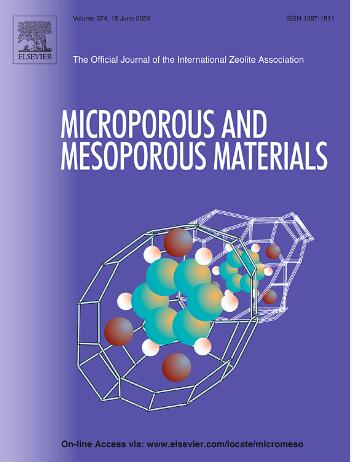Vertically aligned mesoporous silica films bearing covalently bound tris(2,2′-bipyridyl)ruthenium(II) redox photocatalysts
IF 4.8
3区 材料科学
Q1 CHEMISTRY, APPLIED
引用次数: 0
Abstract
This work reports a strategy to prepare mesoporous silica films with preferential vertical alignment of pore channels with covalently attached tris(2,2′-bipyridyl)ruthenium(II) redox photocatalysts, i.e. [Ru(bpy)2(bpy’)]2+ (prepared from a precursor grafting agent containing 2,2′-bipyridine (bpy) and derivatized 4,4′-dimethyl-2,2′-bipyridine (bpy’) units). This was achieved by the electrochemically assisted self-assembly of vertically-aligned mesoporous silica films containing varying amounts of azide groups and their subsequent derivatization by click coupling with an alkyne-bearing [Ru(bpy)2(bpy’)]2+ reagent. The effectiveness of the functionalization processes was monitored by infrared spectroscopy, indicating a best compromise reached for an azide content large enough to immobilize a high content of [Ru(bpy)2(bpy’)]2+ moieties, but not too large to avoid steric constraints and leading to lower yields of the click reaction. The structural integrity (hexagonal order and mesopore orientation) after functionalization was checked by transmission electron microscopy and grazing-incidence small-angle X-ray scattering. The films were generated on transparent indium-tin oxide electrodes and cyclic voltammetry experiments demonstrated a good electrochemical response via electron hopping between adjacent [Ru(bpy)2(bpy’)]2+ moieties immobilized in the nanochannels, which was dependent on the functionalization level and proved stable upon repetitive potential cycling as a result of their covalent attachment to the silica walls. These films also exhibit luminescence, which can be exploited for photoelectrochemical applications, e.g., detection by electrochemiluminescence or electrochemical regeneration of photocatalyst, as illustrated here from preliminary experiments.

求助全文
约1分钟内获得全文
求助全文
来源期刊

Microporous and Mesoporous Materials
化学-材料科学:综合
CiteScore
10.70
自引率
5.80%
发文量
649
审稿时长
26 days
期刊介绍:
Microporous and Mesoporous Materials covers novel and significant aspects of porous solids classified as either microporous (pore size up to 2 nm) or mesoporous (pore size 2 to 50 nm). The porosity should have a specific impact on the material properties or application. Typical examples are zeolites and zeolite-like materials, pillared materials, clathrasils and clathrates, carbon molecular sieves, ordered mesoporous materials, organic/inorganic porous hybrid materials, or porous metal oxides. Both natural and synthetic porous materials are within the scope of the journal.
Topics which are particularly of interest include:
All aspects of natural microporous and mesoporous solids
The synthesis of crystalline or amorphous porous materials
The physico-chemical characterization of microporous and mesoporous solids, especially spectroscopic and microscopic
The modification of microporous and mesoporous solids, for example by ion exchange or solid-state reactions
All topics related to diffusion of mobile species in the pores of microporous and mesoporous materials
Adsorption (and other separation techniques) using microporous or mesoporous adsorbents
Catalysis by microporous and mesoporous materials
Host/guest interactions
Theoretical chemistry and modelling of host/guest interactions
All topics related to the application of microporous and mesoporous materials in industrial catalysis, separation technology, environmental protection, electrochemistry, membranes, sensors, optical devices, etc.
 求助内容:
求助内容: 应助结果提醒方式:
应助结果提醒方式:


